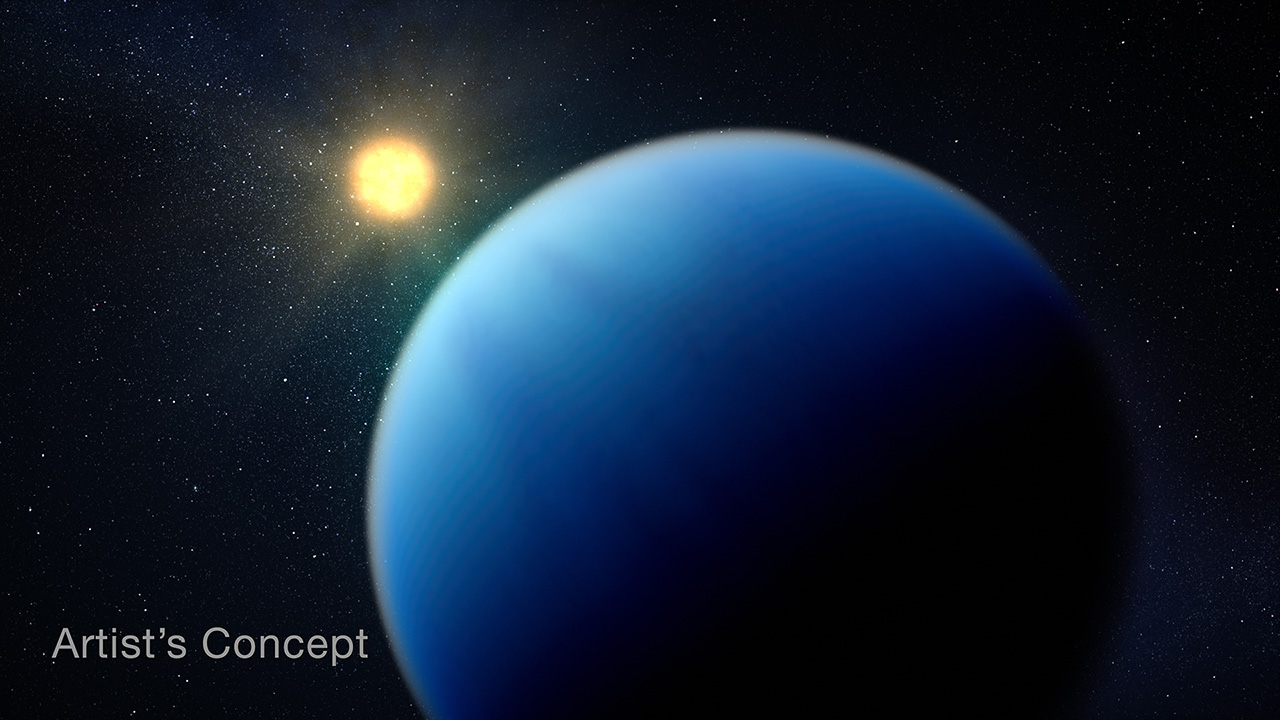James Webb Space Telescope finds water in the air of exotic 'sub-Neptune' exoplanet
"I had been waiting my entire career for Webb so that we could meaningfully characterize the atmospheres of these smaller planets."

NASA's James Webb Space Telescope (JWST) has found water swirling in the air of a distant alien planet, a new study reports.
That exotic world is TOI-421 b, a boiling-hot "sub-Neptune" orbiting a star about 244 light-years from Earth whose atmosphere JWST recently probed in detail.
"One of the most exciting prospects in exoplanet science today is discovering the origin and makeup of sub-Neptunes, which are high-occurrence planets that have no solar system analog," the study team wrote in their paper, which was published Monday (May 5) in The Astronomical Journal Letters.
Although JWST was specifically designed for this kind of investigation, the discovery is particularly exciting because little is known about this class of planets, which were first identified by NASA's pioneering Kepler space telescope. Before JWST, attempts to study the atmospheres of sub-Neptune planets using transmission spectra — the measurement of starlight filtered through a planet's atmosphere when it passes in front of its host star — often yielded flat or featureless spectra.
So, rather than showing chemical fingerprints that could indicate the presence of atmospheric molecules like carbon dioxide, methane or water vapor, the spectra of sub-Neptunes have generally offered little useful information. Astronomers proposed that this lack of detail might be due to clouds or hazes, which could be obscuring the signals.
But the study team thought that TOI-421 b might be different, and could therefore offer a unique opportunity.
"Why did we observe this planet, TOI-421 b? It's because we thought that maybe it wouldn't have hazes," principal investigator Eliza Kempton, a professor of astronomy at the University of Maryland, said in a statement. "And the reason is that there were some previous data that implied that maybe [sub-Neptune] planets over a certain temperature range were less enshrouded by haze or clouds than others."
Breaking space news, the latest updates on rocket launches, skywatching events and more!
Previous observations with NASA's Hubble Space Telescope had shown that flat spectral features are common among sub-Neptunes with temperatures below about 1,070 degrees Fahrenheit (577 degrees Celsius).
"Sub-Neptunes hotter [than this threshold] are also expected to be haze free because methane, and thus the hydrocarbon precursors to haze formation, should be less abundant as carbon monoxide becomes the dominant carbon-bearing molecule," the team wrote in the new study.
TOI-421 b, with an estimated atmospheric temperature of 1,340 degrees Fahrenheit (727 degrees C), falls into this potentially haze-free category — and, after observing two transits using JWST's Near Infrared Spectrograph and Near Infrared Imager and Slitless Spectrograph instruments, the team was rewarded with a rich atmospheric profile.
"We saw spectral features that we attribute to various gases, and that allowed us to determine the composition of the atmosphere," Brian Davenport, a Ph.D. student at the University of Maryland who conducted the primary data analysis, said in the same statement.
The team detected water vapor in TOI-421 b's atmosphere, along with possible signs of carbon monoxide and sulfur dioxide. Notably, they did not find evidence of methane or carbon dioxide. The data also suggest that the atmosphere contains a significant amount of hydrogen.
Some of these findings are surprising, challenging existing theories about the formation and evolution of sub-Neptune planets.
"We had recently wrapped our mind around the idea that those first few sub-Neptunes observed by Webb had heavy-molecule atmospheres, so that had become our expectation, and then we found the opposite," said Kempton. This means TOI-421 b may have formed and evolved differently than cooler sub-Neptunes, such as TOI-270 d, which was observed previously.
The hydrogen-rich atmosphere is especially intriguing because it closely mirrors the composition of TOI-421 b's host star.
"If you just took the same gas that made the host star, plopped it on top of a planet's atmosphere, and put it at the much cooler temperature of this planet, you would get the same combination of gases," Kempton said. "That process is more in line with the giant planets in our solar system, and it is different from other sub-Neptunes that have been observed with Webb so far."
"I had been waiting my entire career for Webb so that we could meaningfully characterize the atmospheres of these smaller planets," she continued. "By studying their atmospheres, we're getting a better understanding of how sub-Neptunes formed and evolved, and part of that is understanding why they don't exist in our solar system."

A chemist turned science writer, Victoria Corless completed her Ph.D. in organic synthesis at the University of Toronto and, ever the cliché, realized lab work was not something she wanted to do for the rest of her days. After dabbling in science writing and a brief stint as a medical writer, Victoria joined Wiley’s Advanced Science News where she works as an editor and writer. On the side, she freelances for various outlets, including Research2Reality and Chemistry World.
You must confirm your public display name before commenting
Please logout and then login again, you will then be prompted to enter your display name.
